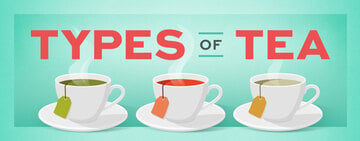Have you ever wondered what goes into the perfect cup of tea? It’s not sugar and milk, but rather a knowledge about minerals, temperatures, and time, although sugar and sweeteners certainly never hurt. Whether you own a cafe or are simply hoping to become a tea connoisseur, you can refer to the infographic below as a quick and easy guide to tea brewing. For a more detailed breakdown of how to brew the best cup of tea, read on to learn more.
Shop All Tea
The Best Water for Making Tea
Water is obviously a key ingredient to any cup of tea, but not all water is equal.
- If you’re using tap water, make sure it’s fresh and cold. You’ll want to avoid tap water that’s been sitting in your kettle for any length of time or that’s been previously boiled. The reason you should use cold water from the tap (as opposed to warm or hot water) is that hot tap water tends to carry more minerals, like calcium and lime, that will affect the flavor of your tea.
- Spring water is preferable to distilled water because it contains just the right amount and type of minerals that will bring out the best flavors.
Tea Brewing Methods
There are so many different ways to brew tea, and many of them simply come down to personal preference. If you’re going with a loose leaf tea, there are several equipment options to choose from.
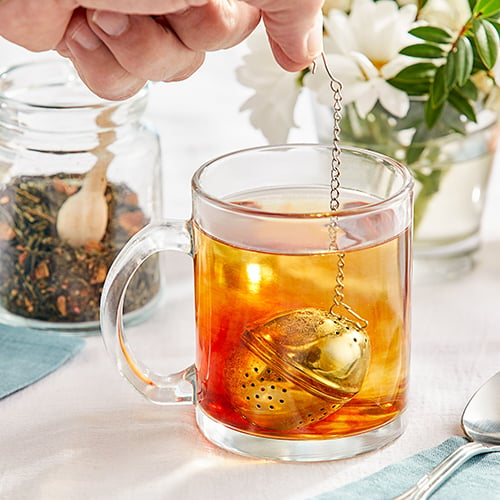
Steeping with a Tea Ball Infuser
These unique infusers are basically meshed spheres with a hinge, which allows you to fill them with loose tea and then clasp them shut. Tea ball infusers work essentially the same way as tea bags, in that you dip them into hot water, and then pull them out when it’s fully steeped. The advantage of using these handy little devices is that they can be used again and again, where tea bags must be thrown away. Another advantage is that you can mix your own blends of different tea varieties to create a signature blend for your restaurant or cafe.
Making Tea in a French Press
You may be familiar with a French press for brewing coffee, but you may not realize that you can use a French press to make tea. One advantage of using a French press to make tea is that you can brew several cups at once. Another advantage of this tool is that you can steep and serve in the same vessel. One of the drawbacks, however, is that you run the risk of over-steeping your tea because the leaves are not removed after brewing, but simply sit at the bottom of the press.
Tea Brewing Strainers
Tea strainers sit over your cup and hold loose leaf tea in a small mesh basket. Tea is made by pouring hot water on top of the leaves, allowing it to pass over them and flow through the mesh of the strainer. The strainer is then removed from the top of the cup before serving. This technique is not very popular and doesn’t give you much control over the length of your brewing time, but if you’re looking to give your customers an elegant and interactive tea experience, this is a good option.
Using a Paper Sachet to Brew Tea
You can purchase ready-made paper pouches for brewing loose leaf tea, or make your own from a coffee filter or other similar food-safe paper. This option is convenient when easy cleanup is a priority because paper teabags are disposable, which will save you time during cleanup.
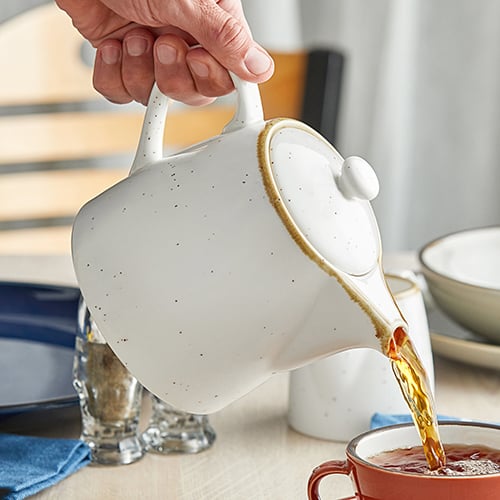
Making Tea in a Teapot
If you’re not interested in any of the aforementioned contraptions for brewing your tea, a good old teapot is always a great choice. But, as with many aspects of the brewing process, not all teapots will deliver the same results. Many teapots have built-in strainers that assist in the infusion process, but others will require the use of a separate straining device. Another major factor to consider is how the material of your teapot retains heat and what tea brewing temperature is ideal for your type of tea (which we’ll get into a little later).
- Iron - Teapots made of iron are common for serving Asian-style green teas, but keep in mind that iron retains heat for a long time, making it a better option for teas that need to be brewed at a higher temperature, such as black tea.
- Glass - Glass teapots not only beautifully showcase the color of your tea but also retain heat well. This means they will deliver the ideal green tea temperature and are great for white tea, as well.
Factors that Impact Tea Flavor
As with any culinary endeavor, several factors will affect the flavor of your product. Knowing the way in which each of these factors impacts your tea will help you come up with a brewing system that works best for you.
Tea Brewing Temperature
A common mistake when brewing tea is to let the water come to a rolling boil. The state of boiling releases oxygen from the water, which prevents your tea from reaching its fullest flavor potential. Different types of tea also taste best when steeped at different temperatures. For example, green tea temperature should be different from black tea. The temperatures in the table below are shown in Fahrenheit.
| Tea Type | Ideal Tea Steeping Temp. |
| White Tea | 175 F |
| Green Tea | 175 F |
| Oolong | 195 F |
| Black Tea | 195-205 F |
| Mate | 208 F |
| Rooibos | 208 F |
| Other Herbal | 208 F |
As you can see, many types of tea taste best when brewed just before the water reaches its boiling point (of 212 degrees Fahrenheit). Even if your water has reached a boil and cools down to the ideal temperature, it still will have released oxygen, so it’s best to start over with new water at that point.
Tea Steep Time
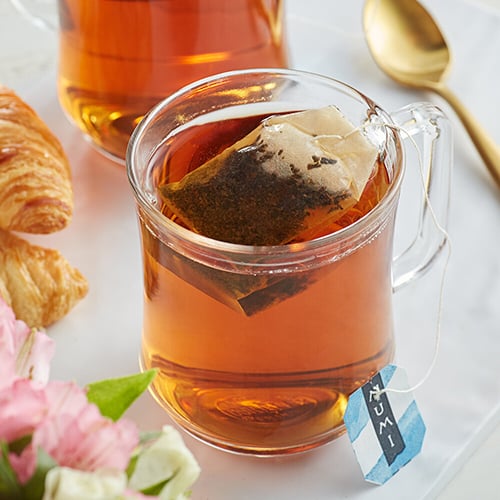
Determining the brew times for tea can be tricky because times can vary widely depending on the type of tea you’re using. On top of that, there are subtle flavors that will emerge as your tea steeps, and many people have different preferences as to which of those flavors is most appealing to them. So, even though there may be a broad guideline for each general variety of tea, it’s suggested that you test out any tea that is new to you and taste it every 30 seconds as it steeps to find the flavor that is best for you. Taking the time to explore these flavor developments will also give you valuable knowledge that you can use while describing each tea to your customers. Explaining the nuances of your teas will impress customers and can help them decide which teas they’d like to try.
Amount of Loose Tea Leaves
Many people think that the longer you brew your tea, the stronger it will be, but the truth is that extending your steeping time will only bring out bitter flavors. If you want your tea to taste stronger, add more tea leaves.
The basic rule of thumb for tea proportions is to use 2 grams of tea for every 8oz of water (more if it's a fluffy variety, like chamomile.)
How to Brew the Best Iced Tea
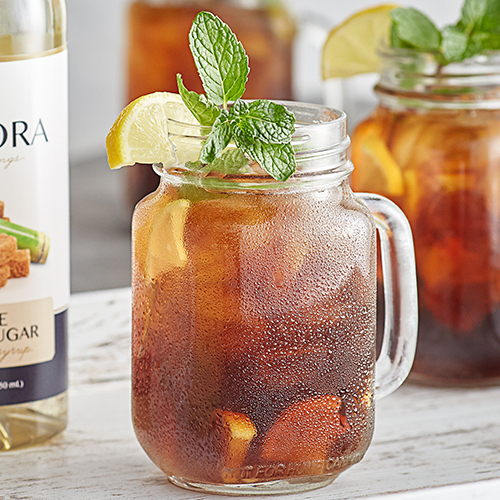
You can use the same tea leaves that you would use for hot tea to make delicious iced tea. There are a few different ways you can brew iced tea, but regardless of which method you choose, you should always double the number of tea leaves that you would use for a hot cup to ensure a robust and flavorful iced drink. As for iced tea-making techniques, the three most common include:
- Hot brew - This is likely the most common technique for brewing iced tea, and it basically entails creating a concentrated batch of hot tea that you then pour over ice and refrigerate. When using a hot brew method, you should add your sugar or honey while the tea is still hot so that it dissolves more completely.
- Cold brew - This method does not entail heating at any point in the process, but rather relies on time to draw flavors out of your tea leaves. Simply place your chosen infusing device in a container of cold water and let it sit in the refrigerator for 6-12 hours. As for sweeteners, agave or simple syrup are a good choice for a cold brew, since they dissolve more easily than regular granulated sugar.
- Sun brew - You may have heard of “sun tea.” This technique is pretty much as simple as it sounds. Just place your tea bag or tea ball in a translucent container of cold water and set it in the sun for a few hours. You can finish your sun tea with fruit juice for a concoction that is entirely your own.
Tea Brewing FAQs
How can I avoid tea leaves settling at the bottom of my cup?
The truthful answer to this question is that if you’re using loose leaf tea, there is no surefire way to prevent some straggler leaves from escaping. The best thing to do about this problem is to simply change your attitude about those pesky little leaves and instead embrace them. The art of tea leaf reading is a magical tradition in many cultures. And in most tea-drinking cultures around the world, it’s customary to leave a centimeter or two of liquid at the bottom of your cup because that’s where the leaves stay, and that’s okay!
Can I make tea in the microwave?
Making tea in the microwave is not recommended because the sharp increase in the temperature of your water impacts the flavor and can cause bitterness.
Can I use the same tea leaves more than once?
Yes. Most kinds of tea stand up well to multiple steepings. The flavor and caffeine won’t be as strong, but as long as it’s not over-steeped or brewed at too high a temperature, you shouldn’t have to worry about bitterness.
As you can see, there’s more that goes into the perfect cup of tea than meets the eye. Also, the more you know about your different varieties of tea, the more prepared you’ll be for answering any questions customers may have. So, next time you go to brew a cup of tea, keep in mind these simple tricks that will enhance the natural flavors of your tea and help you get the most enjoyment out of your hot beverage.
To find other great information about the difference between types of tea, be sure to check out our buying guide.


